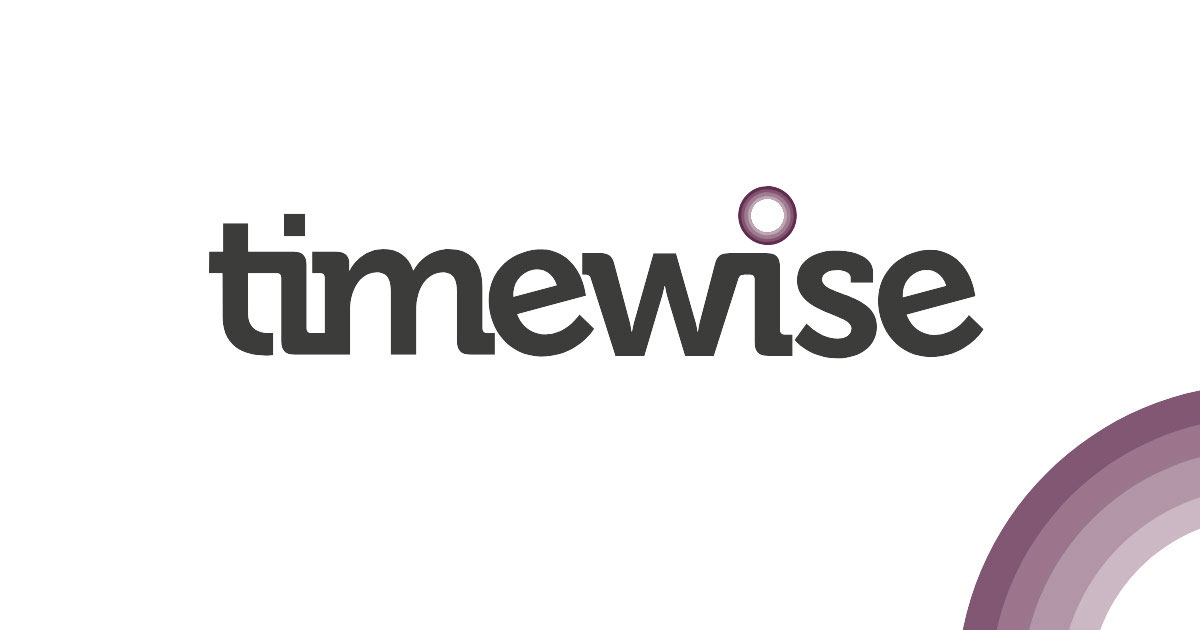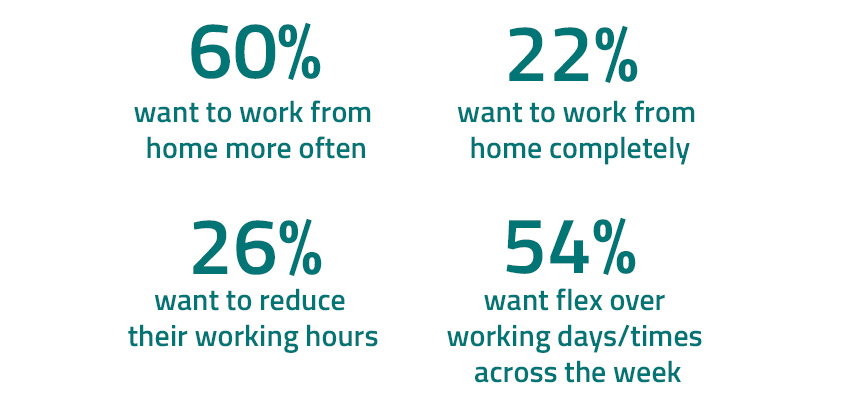

Commissioned by the Greater Manchester Combined Authority, Timewise has examined the region’s jobs market, looking at the proportion of vacancies that offer flexible working. The aim is fair access to quality flexible work - the report suggests there is some way to go.
The Greater Manchester Good Employment Charter sets a high standard for jobs in the region, promoting practices that support diversity and inclusion, and encouraging fair pay. Flexible working is a core part of the charter, and this report by Timewise looks at how well the region is doing when it comes to openly offering flexibility at the point of hire.
The answer is: very slightly better than the national average (at 27% versus 26%), but with some interesting granular differences. For example, in Greater Manchester, flexibility is most available in jobs paying over £60k. This is in sharp contrast to the UK as a whole, where flexibility (mainly in the form of part-time arrangements) has always been most available in low-paid jobs.
And home-working, which is now commonplace for office-based staff, is being offered in only 11% of the region’s job adverts.
There is a clear need for employers in Greater Manchester to do more, and faster. Flexible hiring can reach a wider talent pool – essential in today’s challenging jobs market, where applications are in short supply.
More importantly, flexible working is essential to creating fairer, more inclusive workplaces. It should need no explanation that inclusivity must start at the point of hire, and not be restricted to existing staff. Nor must it be restricted to certain types of jobs or salary levels.
We hope that the Flexible Jobs Index for Greater Manchester will inspire the region’s key anchor institutions to champion flexible hiring as part of their wider inclusive growth strategies. And we hope it will galvanise Greater Manchester employers to consider flexible working as a matter of routine when they advertise jobs – alongside salary, pension and other benefits.
The event was hosted by our Development Director, Emma Stewart, and featured a panel of business leaders who provided their own insights and analysis about what they’re seeing on the ground, as well as their suggestions for what needs to be done to shift the dial. We’ve included a recording of the event below.
Among the key themes which emerged were:
Our thanks got to our panel for sharing their insights and experience: Neil Carberry, CEO, The Recruitment and Employment Confederation; Jonny Briggs, Head of Talent Acquisition and D&I, Aviva; Farrah Ekeroth, Head of Employer Brand, EY and Jane Galloway, Head of Flexible Working, NHS England.
Since March 2020, a workplace revolution has taken place. Pandemic-enforced lockdowns have triggered a huge uplift in remote working, which appears to be here for the long term; at the time of writing, large numbers of employees who previously worked in offices remain home-based, and many companies are offering hybrid working arrangements for their teams.
But while much has been written about the move towards location-based flexible working – that is, people working from home or in other off-site locations – there has been little, if any, attention given to time-based flexible working, particularly part-time. Put simply, the voices of people who cannot work full-time, and their experiences during and after the pandemic, are not being heard.
This report sets out to remedy this omission; to listen to the experiences of part-time workers and job seekers, and understand how the pandemic has impacted them. It builds on the quantitive data from our first Fair Flexible Futures report, providing real-life insights that will help employers, policymakers and labour market intermediaries drive more inclusive policy and practice.

There’s little doubt that the much-predicted skills shortage has arrived. A devastating combination of factors, including Brexit and Covid-19, have led to a recruitment crisis from which no sector is immune, leaving, 70% of businesses facing difficulties hiring staff.
Here at Timewise, we’ve long been clear that offering flexible working is a vital way to gain an edge in this fight for talent. And the business world agrees, with the British Chambers of Commerce’s Jane Gratton noting that “Adopting more remote and flexible working patterns will help firms attract skills from a wider talent pool.”
But while forward-looking employers are listening, and trying to be as open and inclusive as possible in terms of the flexibility they offer, there’s a danger that their approach may be putting candidates off.
Our recent research report, Gaining an Edge in the Fight for Talent, set out to show leaders, recruitment professionals and employer brand specialists how to position their organisations to attract a diverse, inclusive workforce. We surveyed candidates registered on Timewise Jobs, exploring their attitudes towards job seeking and their behaviours during the process.
Some of what we learned wasn’t news to us; the fact that flexibility is more important than salary for many, for example, or that part-time was the arrangement of choice for our candidates (with 80% wanting to work four days per week or fewer). And these are all factors that employers should consider when planning a recruitment strategy.
But what we weren’t expecting to hear was this: One in 10 of our candidates would not apply for a job that is advertised as flexible in generic terms, and a further 3 in 10 would be cautious about doing so. Which means that as many as 40% of applicants are likely to be put off by a vaguely worded flexible offer.
So why is this? Well, firstly, candidates are concerned that unspecific wording may be what we call ‘flex washing’; that is, paying lip service to flexibility to attract applications, but not necessarily offering it in a genuine way. Additionally, candidates who have specific needs, such as only being able to work four days per week, may be unwilling to waste time applying for a job that doesn’t obviously match. And some also fear that they may be discriminated against if they request a specific job pattern that hasn’t been mentioned up front.
Instead, candidates tell us, employers who want to encourage applications by offering flexibility need to do so visibly and clearly. This means:
Of course, as well as saying it, you need to show it. Employer brand is increasingly important in the fight for talent, and candidates will be doing their research. So making sure your approach to flexible working is highlighted on your website and other communications is key. Advertising on a flex-focused jobs board such as Timewise Jobs is also a good way to demonstrate your commitment to flexible working.
You can find out more about what candidates think and how to position your recruitment to win them over within the report. But one thing is certain; however well-intentioned it might be, talking in general terms about the flexibility on offer is not the right place to start.
Published September 2021
In this next pandemic phase, the hiring market must undergo an about-shift to keep pace with the times. This report from Timewise Jobs is for recruitment professionals, employer brand specialists and people leaders who want to best position their organisations to attract a diverse and inclusive workforce.
Amongst its many findings, the research highlights the scepticism that flex-seeking candidates have towards job adverts with generic promises of a flexible working culture. It also provides a vital reminder that remote working is just one form of flexibility, and that candidates’ strong appetite for part-time must not be forgotten in the rush to adapt to hybrid working patterns.
The report concludes by providing clear recommendations to businesses, on how best to articulate flexibility in order to increase job applications and develop employer branding for our new working world.
By Jenny Vadevalloo, Senior Account Manager, Timewise Jobs

As we begin to emerge from Covid-19, and are getting a clearer sense of the way the economy is going, many companies are starting to reboot their hiring strategies. And the focus on hybrid means that more and more employers are building an element of remote working into their roles.
However, there’s another kind of flexible working that can be hugely helpful for employers at this time: part-time. And while the focus on remote working is a positive step, it does mean that part-time is getting less attention. That’s a real shame, because there are some clear benefits to hiring part-timers, especially for SMEs.
Here are some of the reasons why it’s worth building part-time into your recruitment plans.
If you have the budget to recruit a full-time junior employee, it’s worth considering using it to hire a more senior, part-time individual. For the same spend, you’ll get a wealth of experience that a junior employee wouldn’t have; for example, operating at a strategic level, or manging budgets and teams.
Additionally, although they would be working fewer hours, it’s highly likely that a senior part-timer would work more efficiently and independently than someone less experienced, due to the depth and breadth of their knowledge base.
This is certainly the view of Meg Abdy, Development Director of Legacy Foresight, a longstanding client of Timewise Jobs which offers strategic advice to leading charities across the UK, Netherlands and Australia. Their team of highly skilled analysts, researchers and marketing experts have always worked flexibly, at a time and place that suits them.
As Meg notes:
“We’ve found that the best use of our budget is to have someone more experienced and of a higher calibre for, say, two days each week. It means we can trust them to get on and do the job, without having to spend lots of time managing them. They bring a maturity of mindset and skills that you wouldn’t get from a more junior team member.”
Similarly, given the economic impact that the pandemic has had on many companies, hiring a part-timer can be a less risky step to take. And remember it’s not just the basic salary, but also NI and pension contributions, which will be pro-rated.
So if your forecasting is making you wary of taking on financial commitments, but you know you need to add someone into your team, hiring part-time would allow you to bring in the expertise you need, but without a full-time outlay.
Part-time job vacancies are like gold dust; only 8% of jobs are advertised as fewer than five days per week. So by offering a part-time role, you’ll widen your candidate pool to include talented people who want to work, but need a part-time opportunity to do so. This is particularly pertinent at a time when skills shortages are on the rise.
As Meg explains: “Our business requires some very specific skill sets, and needs people with complementary skills who can work closely together. Offering part-time opportunities does give us more choice when it comes to recruiting for these roles, as it opens them up to people who can’t work full time – or prefer not to.”
And there’s an argument that part-time employees offer heightened commitment to their employers, as Meg would agree:
“In our experience, our team appreciates the commitment we are showing them by offering a working pattern that suits their circumstances, which they repay with their loyalty and work ethic. And from our employees’ perspectives, there are no negatives to get in the way of them doing an excellent job.”
The benefits of hiring part-time employees are clear, then; they are also particularly relevant to SMEs. As well as widening your access to candidates, it will allow you to compete for talent against larger businesses and help stretch your budgets. It also offers a soft touch approach to D&I initiatives.
And the good news is, we can help you access them. Timewise Jobs has over 100,000 registered candidates, of which 72% have professional or management experience, and we have a great track record in supporting our clients to find the right people.
As Meg concludes: “We have recruited our last nine employees through Timewise Jobs. They have the right calibre of interesting people on their books, and they really understand what we’re looking for.” We’d be happy to help you in a similar way; feel free to get in touch to find out more.
Published July 2021
Our working practices are changing. From the homeworking revolution to the increase in hybrid working, the debate on productivity and flexibility is likely to rage on for some time. These changes have also exposed and amplified existing inequalities, especially for part-time employees, who often work on the frontline in low-paid jobs.
Early in the pandemic, it immediately became clear that these roles were facing the brunt of job losses and changes in working hours. Furlough has been effective in keeping millions of employees in work, but it is masking significant challenges, especially for part-timers. And as we move towards economic recovery, there is a risk that the gap between the flex haves and have-nots, which existed before Covid-19, will widen significantly, leaving many frontline workers behind.
It is for this reason that we have launched Fair Flexible Futures, a campaign for change with the aim of making good jobs flexible and flexible jobs good. In this, the first in a series of Fair Flexible Futures reports, we present new analysis on how part-time employees are faring, and explore what more needs to be done to support them.

When we set out to create this year’s Flexible Jobs Index, we were pretty sure we’d see a major, pandemic-fuelled shift. There were huge increases in the number of people working from home, as well as a consensus that some of the traditional barriers to flex were falling in the face of necessity. And article after article suggested that employees wanted to continue flexing when the pandemic was eventually over.
It’s for this reason that we split the reporting for this year’s index into three periods; pre-Covid, the first national lockdown, and the first three months of lockdown easing. We recognised that the jobs market has contracted significantly as a result of the pandemic, but we nevertheless expected a bigger proportion of flexibly advertised jobs, and wanted to track the change through all three stages.
So we were disappointed, to say the least, to discover that the gap between the recruitment market and the employment market for flexible jobs grew wider still. The number of people working remotely shot up from 6% before the pandemic to 43% mid-Spring, and settled at 37% by June. But, as our index shows, the proportion of flexibly advertised jobs only rose from 17% before the pandemic to 22% during and since lockdown (with home-working roles representing about one third of those jobs).
To make matters worse, many of the newly created home-based jobs are likely to revert to the workplace as soon as is feasible. And there has been very little movement in the availability of other forms of flexible working, such as part-time and flexible hours.
This matters, a lot, and on many levels. Firstly, the pandemic has decimated the overall jobs market; it halved during lockdown, and was only up to two-thirds of the pre-pandemic level by the end of September. There are more job losses to come, once the furlough scheme finally ends, and more people will be struggling to keep the jobs they have, or find new ones.
And unfortunately, flexible workers will probably be some of the hardest hit, as they are more likely to have additional, complex challenges (such as caring commitments, or health issues) or to work in disappearing frontline jobs (such as retail or hospitality). As a result, they are at a higher risk of falling out of the workplace than their non-flex counterparts.
The knock-on effect of all of this is that the brunt of the pandemic-induced economic crisis is being borne by low-paid workers, and particularly by women. The Resolution Foundation has shown that one third of those in the lowest-paid quartile (who are disproportionately likely to work part-time) have lost their jobs, been furloughed, or lost hours and pay, compared to 15% of the highest paid.
Indeed, at the time of writing, data from LinkedIn has revealed that the percentage of women hired during the lockdown fell, while the percentage of men being hired increased. It also indicated that women over the age of 30 were least likely of all to be hired.
Clearly, then, the economic impact of the pandemic has been devastating, and is likely to continue to be so for some time to come. But alongside the challenges, there is an opportunity, as we rebuild the economy, to create a more level playing field for those who do and don’t need to flex.
Employers can’t wave a magic wand and create jobs that aren’t viable within the current market. But what they can do, and must do, is make sure that any vacancies they do have incorporate as much flexibility as possible, and are advertised as such. If they don’t, there’s a risk that the people who need to work part-time, or from home, or with staggered start and finish times, will be ‘flexcluded’ from the workplace, both now and well into next year.
And yes, we recognise that it’s a tough time for employers as well as employees. But for the sake of fairness, and to support the people who need it most, as well as ensuring businesses don’t miss out on the right talent, we must keep working towards a flexible jobs market. Let’s hope that, by next year’s index, we’ve managed to shift the dial.
Published December 2020
Many jobseekers have had to put their jobsearch on hold during lockdown. The jobs market has declined significantly, as employers have had to batten down the hatches and adapt to new ways of working, deal with furloughs and redundancies, and in many cases fight for survival.
91% of jobseekers in our survey are understandably nervous about the future jobs market. And, like everyone else, many are dealing with increased pressures at home. So the survey’s first significant heads-up for employers is this: while just over half of those in work have perhaps decided it’s safer to stay put in their current jobs, a sizeable minority (45%) will look to move jobs as soon as they can.

Any employers thinking that retention will not be an issue for a few months, may need to think again. And when the need to recruit arises, they are likely to find that the ground has shifted.
People have had four months of experiencing that jobs can be done from home, and that a 9 to 5 routine isn’t necessary. And fears of the virus are still understandably strong – 71% worry they may catch it on their commute; 76% worry about catching it at their workplace.
So it’s no surprise that when people apply for jobs, they will be looking for flexible working.

This isn’t just a case of people wanting to continue working from home. Our survey found significant levels of interest in all forms of flexible working. The proportion wanting to reduce their hours (26%) is particularly interesting – possibly suggesting that people’s values have changed as a result of covid-19, as they’ve had time and reason to reassess ‘what really matters in life’.

Our recommendation to employers is not to fear the increased demand for flexibility, but to embrace it. The last four months have proved just how productive flexible working can be, and has swept away many of the previous objections and perceived barriers. Separated physically from their colleagues, line managers will have been learning how to judge performance based on outcomes, not on the number of hours spent visibly at a desk. So now is the time to grasp the opportunity, hold on to all the positives of remote working and variable hours, and embed sustainable flexible practices into our workplaces.
Employers’ reputations are at stake here. During lockdown more than ever before, organisations have been watched by their staff. People are observing how well business leaders rise to the challenge of the pandemic and deal fairly with their people, respecting their needs for safety and for the space to take care of the non-working parts of their lives.
The good news is that most employers do seem to have been sympathetic to their staff during lockdown, and supportive of the extra stresses that the virus has brought. The vast majority of the people we surveyed said their employers were either ‘very supportive’ or ‘quite supportive’ across several different measures.

How well organisations continue to meet the needs and expectations of their staff will be vital to employer brand. A consultative, supportive approach will earn the most respect – it will be important to check in with people to ask how they are feeling, post-lockdown, and adopt inclusive working practices going forwards.

Research published July 2020
Methodology: The survey was promoted to the Timewise Jobs database in June 2020. 1,000 jobseekers took part.

The news that there are now over 1 million part-time employees at senior or management level is definitely worth celebrating. It’s not just a big number, it’s an indication of a real shift in attitudes and culture. Especially compared to the bad old days, when this kind of flexing only really went on under the radar.
It was the secrecy attached to part-time leadership that led to the launch of the Timewise Power 50 in 2012. We knew people were doing it, but they were doing so very quietly, so we set out to create some noise. And now, eight years on, many senior part-timers are loud and proud.
So is our work done? Should we raise a glass to what we’ve achieved, and move on? You won’t be surprised to hear that my answer is no.
While it’s great that so many senior part-time requests have been accommodated, what happens when the individuals involved want to find their next promotion? The data suggests they are likely to struggle; as we revealed in this year’s Flexible Jobs Index, only 15% of jobs are currently advertised as having any flexibility at all.
What this means is that these senior flexers are in danger of having no flexible next step, or having to trade their hard-won flexibility away to keep climbing. It’s almost like a game of musical chairs; sure, you can grab your bit of flex, but you won’t necessarily get to keep it if you go for a promotion.
If we’re going to keep moving forwards, we can’t just settle for helping people find a way to make their current job flexible. We also want them to be able to take their arrangement to the next one, and the one after that, and the one after that. And that means we need to make flexible recruitment into the next big thing.
How? Well, experience has shown us that what gets measured gets changed. For example, a focus on the gender split at board level has resulted in women holding one third of board roles at FTSE 100 companies. And following the legislation requiring companies to track their gender pay gap, things are starting to move in this area too.
It’s reasonable to assume, then, that a similar requirement for companies to track flexible hires and promotions would help speed up the pace of change. And while this would need to be tackled at governmental level, we all have a part to play.
So if you’re hiring flexibly already, that’s brilliant. Keep doing it, and do it more. Shout about it on your website and highlight it when you’re briefing recruitment agencies. Be upfront on your ads that you’re happy to discuss flexible options (having first made sure the roles you’re offering can work on that basis).
If you’re not, it’s definitely time to get started – and we can help. Do get in touch with the team, so we can support you as you take your next step.
Published February 2020